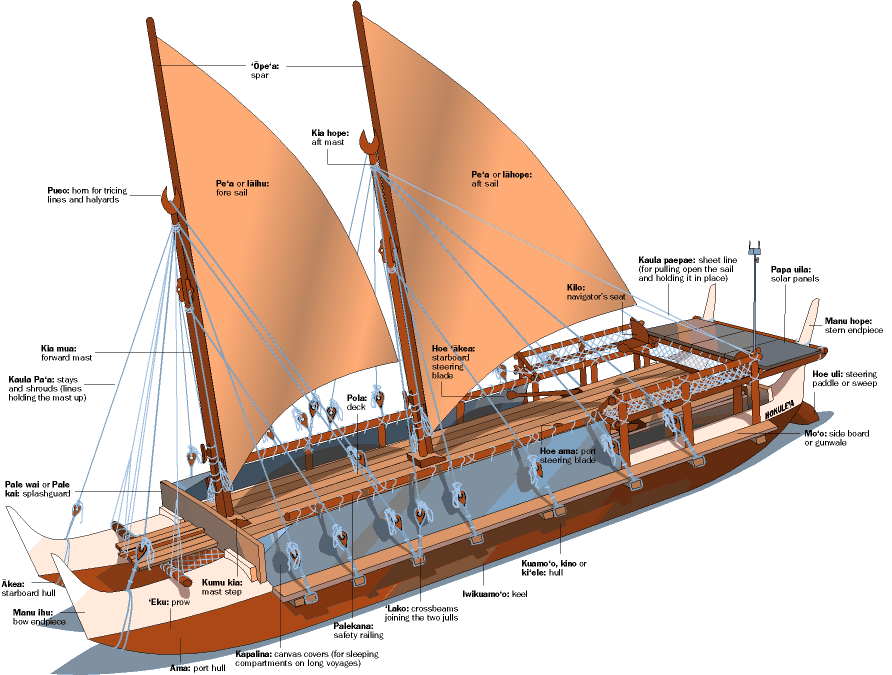Ancient Polynesian Catamarans: Precursors to the Modern Catamarans
- amanda@amandamcetas.com

- May 1
- 3 min read
Last month, my family celebrated 30 years of visiting Rocky Point, Mexico with many of our extended family and childhood friends. We had a great time sailing, playing in the sand and surf, dining together, and sharing memories by the firelight in the evenings.

While I was out sailing on the catamaran with a dear friend, he was talking to me about one of his favorite TV series from the History Channel, “Ancient Aliens”. Now I will admit that I have watched some of these shows from time to time. It does have entertainment value.
As a history teacher, though, I was always annoyed with the premise of the show – that ancient humans were somehow too stupid to develop their technologies, innovations, and structures on their own – that they needed intervention from more advanced aliens from some other planet. The more I study history, the more I am convinced that ancient humans were not any less intelligent than we are. In fact, they were created in the image of God and had the capacity for creativity, critical thinking, and wisdom.
Our ancient ancestors may not have the same amount of knowledge or modern resources, but they were clearly inventive and resourceful. In fact, I would argue that many technologies they developed haven’t really changed much, only the materials used to construct them.
And sailing on the catamaran with my friend was a perfect example of this theory. Here is what I found out about the ancient Polynesian catamarans.
Ancient Polynesian catamarans, known as double-hulled canoes or "wa'a kaulua" in Hawaiian, were integral to the Polynesians' remarkable oceanic explorations. These vessels featured two parallel hulls of equal size, connected by crossbeams, providing exceptional stability and ample space for carrying passengers, food, and essential supplies necessary for long voyages across the Pacific Ocean. [1]
The design of these catamarans enabled Polynesian navigators to undertake extensive voyages, leading to the settlement of islands across the vast Polynesian Triangle, which spans from Hawaii to New Zealand and Easter Island. Navigators employed sophisticated wayfinding techniques, relying on observations of the stars, ocean currents, wave patterns, and the flight paths of birds to traverse thousands of kilometers of open ocean without modern instruments. [2]
In the 20th century, there was a resurgence of interest in traditional Polynesian navigation and vessel construction. Notably, in the 1970s, the Polynesian Voyaging Society built the Hōkūleʻa, a replica of an ancient Polynesian voyaging canoe, to demonstrate the efficacy of traditional navigation methods. This initiative sparked a renaissance in traditional seafaring practices across Polynesia and beyond. [3]
The legacy of ancient Polynesian catamarans endures today, inspiring modern designs and a renewed appreciation for traditional navigation techniques. Organizations and enthusiasts continue to study and celebrate these remarkable vessels, ensuring that the knowledge and skills of Polynesian wayfinding are preserved for future generations.[4]

(Right) Hawaiian Catamaran Model: This handcrafted model showcases a traditional double-hulled canoe with a thatched shelter and a triangular sail, reflecting the materials and techniques used by ancient Polynesians.

Tongan Catamaran Diagram: A detailed illustration highlighting the structural components of a Tongan catamaran, including the hulls, sails, and connecting beams, providing a technical perspective on its construction. Getty Images

Polynesian Voyaging Canoe Illustration: An artistic rendering of a double-hulled canoe in action, complete with sails and crew, capturing the vessel's functionality and the skill of its navigators

Hōkūleʻa Voyaging Canoe: Photographs of the Hōkūleʻa, a modern replica of traditional Polynesian voyaging canoes, demonstrate the enduring legacy and continued use of these designs in contemporary times.
If you are interested in some STEM activities for your children/students related to this topic you can download them from my publisher's website by clicking the link below.
If you have any ideas for future topics, or want to comment on this one, you can respond below.
Thanks for reading!
[1] Clark, Liesl (15 February 2000). "Polynesia's Genius Navigators" PBS. Retrieved 27 April 2025
[2] Lewis, David (1972). We the Navigators, The Ancient Art of Landfinding in the Pacific. Starpath. Retrieved 27 April 2025
[3] Randall, Brianna. “Off the Charts: How a Polynesian canoe Inspired a Renaissance in Traditional Seafaring,” The Guardian.Retrieved 27 April 2025.
[4] Randall, Brianna. “Off the Charts: How a Polynesian canoe Inspired a Renaissance in Traditional Seafaring,” The Guardian. Retrieved 27 April 2025.




Comments